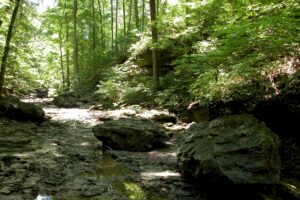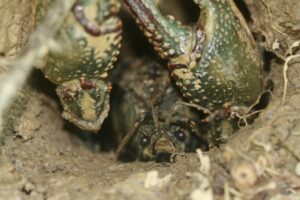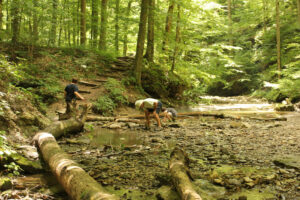By Bernheim
 Rock Run Loop is my trail of choice at Bernheim. This single location can ignite feelings peace, joy, or wonder depending on the circumstances. Standing still in the shade of the towering trees, listening to the Wood Thrush’s flute-like song while admiring the green mosses and ferns brings me to a serene mindset difficult to achieve elsewhere. If my dog is with me, I fill with immense delight watching him investigate every nook and cranny while happily frolicking in the cool waters. But perhaps my favorite set of circumstances are when I have a group of eager school children with me, excitedly huddled around a curious critter.
Rock Run Loop is my trail of choice at Bernheim. This single location can ignite feelings peace, joy, or wonder depending on the circumstances. Standing still in the shade of the towering trees, listening to the Wood Thrush’s flute-like song while admiring the green mosses and ferns brings me to a serene mindset difficult to achieve elsewhere. If my dog is with me, I fill with immense delight watching him investigate every nook and cranny while happily frolicking in the cool waters. But perhaps my favorite set of circumstances are when I have a group of eager school children with me, excitedly huddled around a curious critter.
On the surface, Rock Run is a chronicle of weathering and erosion: how over millennia, water can slowly make incredible changes to our landscape. This story is easy to read by the grooves in the hillside, carved limestone cliffs, and sound of trickling water echoing off the rock faces. But hidden beneath the pools and ripples of the creek lies another tale, one that is vibrant, energetic, and always changing. The aquatic life within Rock Run is astounding but can be difficult to notice beside the occasional startled frog or darting school of fish. If you know where to look or are amongst a group of eagle-eyed school children as I often am, you will find a world full of fascinating creatures, each using their adaptations to survive and thrive.

Take for example the simple crayfish. Sightings of these invertebrates are a guarantee when scanning the waters of Rock Run, yet catching them is far from certain. Using their strong abdominal muscles, they can swim backwards extremely quickly when threatened, making them difficult to catch. If you do manage to hold one, watch out for its strong pincers, or chelipeds, which they use to defend themselves by giving quite the pinch! These crustaceans are ‘opportunistic omnivores’ and will sit beneath the edges of rocks in the creek bed, grabbing whatever organic matter floats downstream. Often, they will eat a variety of aquatic plants, mollusks, insects, tadpoles, amphibian eggs, and small fish, but also work as decomposers, breaking down dead and decaying matter that floats by. If you are lucky, you may find a female crayfish who has recently laid eggs: she will carry hundreds of eggs, then offspring, on her tail for over a month!

Vigilant explorers may find one of Rock Run’s most elusive, extraordinary organisms. Salamanders are plentiful in Rock Run, yet are secretive and difficult to discover. These creatures must stay moist: in Rock Run, the larval forms can often be found under rocks, nuzzled into the pebbles and sand of the wet creek bed, while adults are typically in damp areas under rocks or logs near the flowing water. The reason they must stay moist is that they have permeable skin, which means liquids and gases are absorbed into their bodies. This trait helps them breathe, but also makes them incredibly sensitive to polluted waters. For this same reason, if you find one, be sure not to handle it: they can absorb the sweat, oils, and chemicals on your hands into their bodies. Here at Bernheim, we have documented 15 different species of salamanders within our creeks, swamps, and ephemeral pools.
If you go to the water’s edge, find a flat rock, and gently turn it over, a neighborhood of diversity can be found. On the underside of a single rock, you often will be greeted with a variety of invertebrates, all squiggling away from your fingertips. Interestingly, many of these are the larval forms of insects who take flight once they are adults. You may encounter some of these critters:
- Water penny beetle larva: Flat and round, this insect looks like a small coin, and slowly meanders its way across rock bottoms, nibbling on algae.
- Stonefly larva: These insects have a flattened body, tuft-like gills under their legs, and two long, antenna-like tails. Stonefly larva scurry across rock bottoms eating algae, plant material, and occasionally smaller invertebrates.
- Mayfly larva: Similar in looks to the stonefly, mayfly give a clue of their identity to careful observers: their three long tails look like an ‘M’, which stands for Mayfly! They crawl around eating algae for up to two years: once they take flight as adults, they have no mouthparts and live mere days simply to reproduce. Their short adult lifespan is the source of their order name, Ephemeroptera, or “ephemeral wing’.
- Caddisfly larva: Odds are you will not see this insect… you will see its home! Caddisfly larva are incredible engineers, and build cases made of sand, plants, and rock around their bodies for protection. Often, they spin these cases in the shape of a tube or cone, but occasionally you will find one built to look like a snail shell.
 These four invertebrates are what we call indicator species: they can only survive in pristine waters and their presence suggests excellent water quality. The fact that all can be found in Rock Run Creek is a clear sign that Bernheim’s efforts to preserve crucial habitats and protect headwater streams have been successful. Including Rock Run, over 91 miles of streams are housed with Bernheim’s borders.
These four invertebrates are what we call indicator species: they can only survive in pristine waters and their presence suggests excellent water quality. The fact that all can be found in Rock Run Creek is a clear sign that Bernheim’s efforts to preserve crucial habitats and protect headwater streams have been successful. Including Rock Run, over 91 miles of streams are housed with Bernheim’s borders.
I highly suggest that everyone take a stroll down this extraordinary trail and creek. Listen to the story the water tells as it trickles down the hillside, creeps through the mosses and ferns, drips off rock faces, and finally reaches the creek bed to flow on to its next destination. Spend time seeking out the many living and nonliving things that call this place home, searching for the connections that bind them all together. These connections are abundant: if they could be seen, Rock Run would become a tapestry, a valley full of colorful threads weaving together from every direction. It is easy to forget, but vital to remember, that every blade of grass, drop of dew, and unassuming invertebrate are important. Pieces of a puzzle, like you and I, that together create the portrait of life as we know it.
So, head down to Rock Run Loop – the trailhead is the first one you’ll come to driving up Forest Hill Drive. Watch crayfish dash around the pools and pause on your journey to flip a few rocks in search of critters or fossils. Always move rocks slowly, watch the waters carefully, then gently replace the rock where it belongs. With a thoughtful hand and careful eye, a fascinating world filled to the brim with life, curiosities, and wonders will reveal itself to you.
Thank you to the James B. Beam Natural Water Sanctuary Alliance at Bernheim which helps support some of Bernheim’s water conservation and education programs, as well as education regarding the importance of preserving biological diversity.

